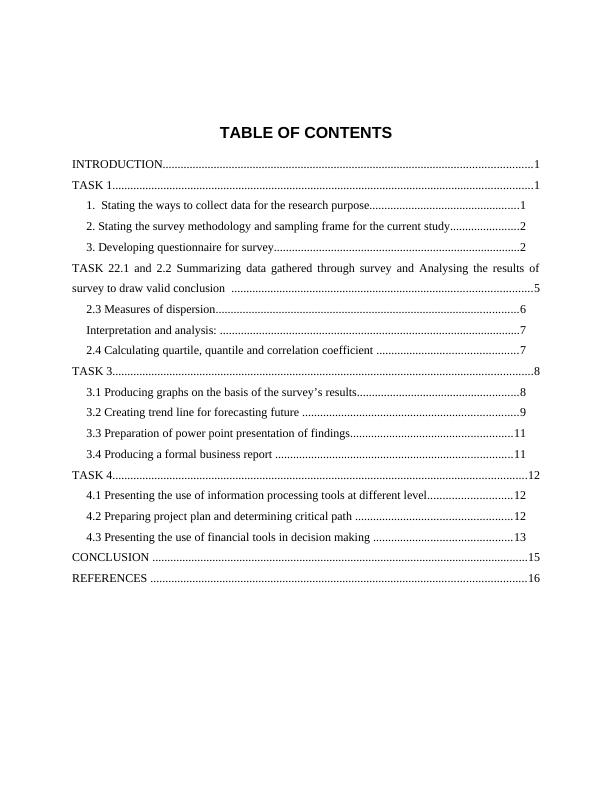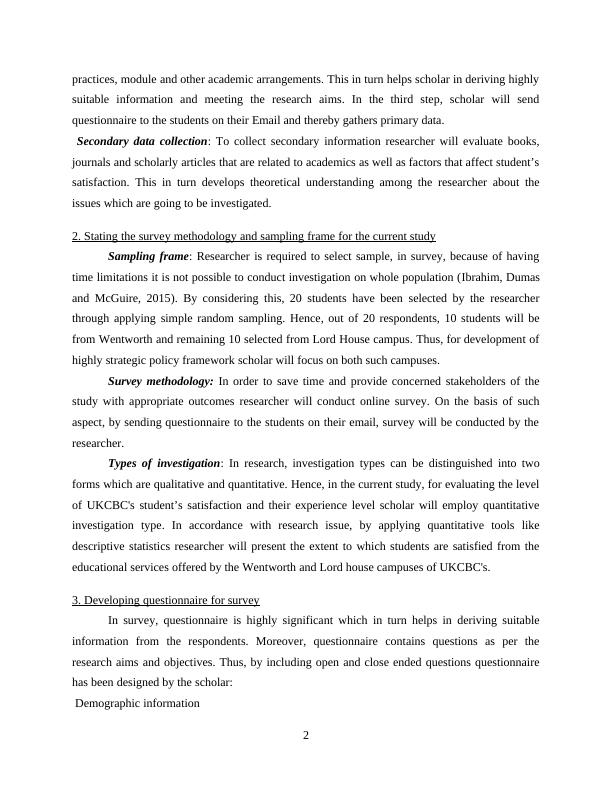Table of Contents for Business Decision Making
Added on 2020-06-05
19 Pages3993 Words361 Views
Business DecisionMaking

TABLE OF CONTENTSINTRODUCTION...........................................................................................................................1TASK 1............................................................................................................................................11. Stating the ways to collect data for the research purpose..................................................12. Stating the survey methodology and sampling frame for the current study.......................23. Developing questionnaire for survey..................................................................................2TASK 22.1 and 2.2 Summarizing data gathered through survey and Analysing the results ofsurvey to draw valid conclusion ....................................................................................................52.3 Measures of dispersion.....................................................................................................6Interpretation and analysis: ....................................................................................................72.4 Calculating quartile, quantile and correlation coefficient ...............................................7TASK 3............................................................................................................................................83.1 Producing graphs on the basis of the survey’s results......................................................83.2 Creating trend line for forecasting future ........................................................................93.3 Preparation of power point presentation of findings......................................................113.4 Producing a formal business report ...............................................................................11TASK 4..........................................................................................................................................124.1 Presenting the use of information processing tools at different level............................124.2 Preparing project plan and determining critical path ....................................................124.3 Presenting the use of financial tools in decision making ..............................................13CONCLUSION .............................................................................................................................15REFERENCES .............................................................................................................................16

INTRODUCTIONIn the present era, business decision making has become highly complex due to rise inlevel of competition. Further, there are several factors such as changes in the expectation oftarget market; technological advancements etc which in turn has direct impact on the growth andsuccess of organization. The present report is based on UKCBC which is one of the well-knownand leading institutions of UK. It offers highly advanced educational facilities to the students thataid in their career growth. In this, report will provide deeper insight about the manner throughwhich scholar can gather primary and secondary data for meeting the research purpose. Besidesthis, study will also shed light on the research tools like survey methodology and samplingframe. Further, report will depict the manner in which large data can be simplified for thepurpose of decision making. Hence, it will exhibit the use of statistical techniques in gettinginformation about the extent to which students are satisfied from the services offered byUKCBC. This report will also highlight the significance and use of investment appraisal tools indecision making.TASK 11. Stating the ways to collect data for the research purposeIn the field of research, data gathered by scholars have direct influence on theappropriateness of outcome. Thus, there are mainly two types of sources that researcherundertakes to gather data namely primary and secondary. Sources for primary data collectioninclude survey, focus group, observation etc. On contrary to this, through internet surfing onecan access books, journals and articles that are related to the research issue (Collier, 2015).Hence, with the motive to get information about the satisfaction as well as experience of thecustomers scholar will gather data from both primary as well as secondary sources. Ways andsources to collect data for the concerned research are enumerated below: Primary data collection: For the collection of primary data scholar will conduct survey viaquestionnaire. The rationale behind the selection of such method is that it helps in collectinghighly appropriate information in line with the research issue. Thus, for the purpose of primarydata collection 20 students of UKCBC has been selected by the scholar. Moreover, it is notpossible for the researcher to conduct study on whole population. Once, sample has beenselected, thereafter scholar will frame questionnaire by including questions about the teaching1

practices, module and other academic arrangements. This in turn helps scholar in deriving highlysuitable information and meeting the research aims. In the third step, scholar will sendquestionnaire to the students on their Email and thereby gathers primary data. Secondary data collection: To collect secondary information researcher will evaluate books,journals and scholarly articles that are related to academics as well as factors that affect student’ssatisfaction. This in turn develops theoretical understanding among the researcher about theissues which are going to be investigated.2. Stating the survey methodology and sampling frame for the current studySampling frame: Researcher is required to select sample, in survey, because of havingtime limitations it is not possible to conduct investigation on whole population (Ibrahim, Dumasand McGuire, 2015). By considering this, 20 students have been selected by the researcherthrough applying simple random sampling. Hence, out of 20 respondents, 10 students will befrom Wentworth and remaining 10 selected from Lord House campus. Thus, for development ofhighly strategic policy framework scholar will focus on both such campuses. Survey methodology: In order to save time and provide concerned stakeholders of thestudy with appropriate outcomes researcher will conduct online survey. On the basis of suchaspect, by sending questionnaire to the students on their email, survey will be conducted by theresearcher. Types of investigation: In research, investigation types can be distinguished into twoforms which are qualitative and quantitative. Hence, in the current study, for evaluating the levelof UKCBC's student’s satisfaction and their experience level scholar will employ quantitativeinvestigation type. In accordance with research issue, by applying quantitative tools likedescriptive statistics researcher will present the extent to which students are satisfied from theeducational services offered by the Wentworth and Lord house campuses of UKCBC's. 3. Developing questionnaire for surveyIn survey, questionnaire is highly significant which in turn helps in deriving suitableinformation from the respondents. Moreover, questionnaire contains questions as per theresearch aims and objectives. Thus, by including open and close ended questions questionnairehas been designed by the scholar:Demographic information2

End of preview
Want to access all the pages? Upload your documents or become a member.
Related Documents
Business Decision in Workplace : Reportlg...
|34
|5611
|28
(DOC) Business Decision Making - UKCBClg...
|24
|5456
|477
Business Decision-Making Assignmentlg...
|28
|5185
|47
Planning and preparation of primary and secondary data for BDM INTRODUCTION 3lg...
|17
|3471
|455
Business Decision Makinglg...
|29
|5343
|439
Unit 6 Business Decision Making Tools Assignment (Doc)lg...
|17
|3797
|165
